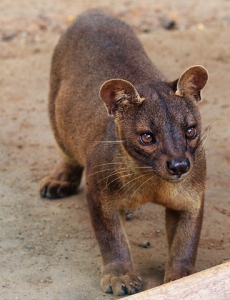We are often asked about civet ‘cats,’ genet ‘cats’ or other animals that are not actually members of the Felidae (Cat) Family.

Civet cats, genet cats, fossas, bearcats (also known as binturongs)…are these really cats? No. These animals belong to the familes Viverridae, or Eupleridae, found only in Africa, the Middle East, southern Asia and southern Europe.
These animals resemble spotted or striped, long-nosed cats with long, slender bodies and pointed ears. The diet of most species consists of small mammals and birds, insects, reptiles and fruit. Most have partially or totally retractile claws, webbing between the toes and long tails that are equal to, or longer than, their bodies.
Many are tree dwellers (especially the civets and genets) but others spend most of their time on the ground. They range in size from the half kilogram (1 lb) dwarf mongoose to the 14 kg (29 lb) African civet. Prior to the domestication of cats, genets were kept by Europeans for their ability to catch rats.
While they share many similarities in behaviour and anatomy with the Felidae or cat family, civets, genets and their relatives also possess scent, glands that secrete a greasy, pungent fluid still used in the perfume and medicinal industries. This nauseous smelling liquid is used by all members of this family for defense, and to mark their territories.
Fossas of Madagascar are the largest carnivore on that island, and are particularly cat-like animals. It was, in fact, once considered a cat because of the cat-like shape of its head, with shortened face, rounded ears and body form. They are nocturnal, live in the forests and feed exclusively on meat. Today the fossa is included in the Euptileuridae Family which are found only on Madagascar. The similarities to cats are thought to be the result of similar evolutionary paths, or convergent evolution. On their isolated island, fossas lacked any competition from cats and were able to slowly evolve to exploit the niche of a medium sized predator on lemurs, bats and birds.
Palm civets, or civet cats as they are commonly called, are found in Asia. They are popular as food items in restaurants, and are raised on game farms in mainland China for this purpose. In 2003, with the outbreak of severe acute respiratory syndrome, or SARS, in China, five civets were discovered to be carrying the coronovirus thought to cause SARS in humans. It was later discovered that the virus found in the civets was not identical to the one found in humans. The virus found in the civets was also found in the raccoon dog and the ferret badger, both of which are popular in restaurants in Asia.
Genet cats live throughout Africa, with one species, the small spotted genet, found in parts of Spain, Portugal and France. They are silent and stealthy hunters. When stalking prey, they crouch until the body and tail seem to glide along the ground, and the body seems to lengthen. These animals can go through any opening the head can enter, because of the slender and loosely jointed body. Genets sometimes take game birds and poultry, and the population in Europe has declined because of persecution for this habit.
Binturongs, or bear cats, are another member of the Viverrid family referred to as a cat. Measuring up to 90 cm (36″) in length, with over half their length being tail, the binturong is covered with black, coarse hairs with a speckled gray head and long white whiskers. They are one of only two carnivores with a prehensile, or gripping tail. With their short legs and bear-like walk, they are commonly referred to as bearcats. They are arboreal animals that live in the dense forests of south east Asia, either alone or in a female-dominated group with their offspring. Much of their diet is fruit, but as carnivores they eat a certain percentage of birds, small mammals and even fish.
Mr. Guilt
I always like to remind the University of Cincinnati grads around me that to call their mascot a “cat” is bintuWRONG!
(UC’s mascot is the Bearcats. One binturong from the Cincinnati Zoo, Lucy, occasionally visits the games).